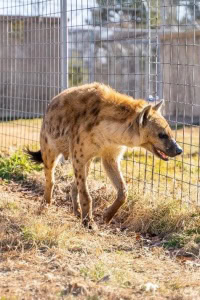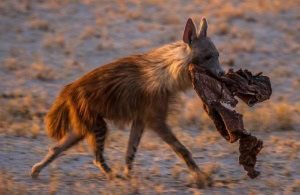
Turpentine Creek Wildlife Refuge is home to almost 100 animals which includes ‘Lions, Tigers, Bears … oh my!’ But along with all the big cats and bears, we also house bobcats, cougars, and servals. A spotted hyena is one of the latest additions to our collection of all the species that call TCWR home! Rambo, the hyena, came to TCWR on February 22nd of 2020 from southern Arkansas when his previous owner passed away, and the rest of the family could no longer care for him. Since then, he has been living at Rescue Ridge and enjoys his new home a lot, along with all his neighbors.

Picture Source: Google Images
There are three sub-species of hyenas in the wild:
- Crocuta crocuta (Spotted Hyena)
- Hyaena hyaena (Striped Hyena)
- Parahyaena brunnea (Brown Hyena)
The Taxonomy of spotted hyenas are as follows:

Picture Source: Google Images
Kingdom: Animalia
Phylum: Chordata
Class: Mammalia
Order: Carnivora
Family: Feliformia
Subfamily: Hyaenidae
Genus: Crocuta
Species: Crocuta

Picture Source: Google Images
Hyenas call Africa home, especially south of the Sahara Desert. They are widespread and found in most habitats. Spotted hyenas live in all types of habitats, including savannas, grasslands, woodlands, forest edges, sub desert, and even mountains (up to 4,000 meters). Instead of finding a den or cave, they would rest where they can find some shade, such as shallow pools or under bushes and trees. The population of Hyenas is currently less than 14,000 individuals.

Hyenas indeed are strange animals. They are large mammals that can weigh 77 to 190 pounds, depending on their gender and age. These animals can get up to 4 to 6 feet in length and up to 2.5 to 3 feet in height. They have relatively short torsos with lower hindquarters and sloping backs. Generally, people tend to believe that Hyenas are related to dogs, but they are more closely related to the cat family. The Mongoose and the Meerkat are Hyena’s closest relatives. Depending on the conditions of their living space and their diets, Hyenas can live up to 30 to 40 years in captivity and up to 20 years in the wild.
![]()
Hyenas are very social animals. In the wild, they live in clans that contain up to 80 individuals. The clans follow a matriarchal pattern where the females rule over the males. In time both males and females become more dominant and more aggressive towards one another. As the females give birth to their cubs, they invest more time and energy on them than any other terrestrial carnivore. This behavior is unlike any other female organisms caring for their offspring; human beings are an exception.
![]() Hyenas have such odd but exciting features! Did you know that Hyenas eat anything and everything? The only problem they have is digesting hairs, horns, and hooves. But if needed, they can regurgitate those in pellet forms. They also have excellent nighttime vision and excellent hearing. Hyenas make a lot of different noise, which includes: whooping noise, laughs, and groaning. People can hear hyenas ‘laugh’ up to 3 miles away. Hyenas make this particular type of noise to alert the clan about foods and intruders. Their ‘laughing’ noise interprets as a stress response under certain circumstances. The strangest thing about a Hyena’s heart is that it is twice as large as other mammals that are similar to the size of hyenas.
Hyenas have such odd but exciting features! Did you know that Hyenas eat anything and everything? The only problem they have is digesting hairs, horns, and hooves. But if needed, they can regurgitate those in pellet forms. They also have excellent nighttime vision and excellent hearing. Hyenas make a lot of different noise, which includes: whooping noise, laughs, and groaning. People can hear hyenas ‘laugh’ up to 3 miles away. Hyenas make this particular type of noise to alert the clan about foods and intruders. Their ‘laughing’ noise interprets as a stress response under certain circumstances. The strangest thing about a Hyena’s heart is that it is twice as large as other mammals that are similar to the size of hyenas.
![]()
Hyenas are also very bright! In multiple experiments, spotted hyenas had outperformed chimpanzees when it came to collective or group problem-solving skills, showing that in various ways, hyena intelligence may even exceed some of the great apes in certain aspects. Did you know that hyenas can also count? Studies have shown that spotted hyenas can determine the number of other hyenas in a rival clan and decide their best course of action. After a quick census, male hyenas looking to join a new clan will always choose the clan with the least number of other males.
![]()
![]()
Every animal in our sanctuary has a specific diet based on its physiological conditions. Rambo gets 3 lbs. of meat every day. Then, to sporadically replace his diet, he will get a whole carcass, typically rabbit. Here at TCWR, we believe that animals’ mental health is just as important as their physical needs. So, on top of his regular diet, Rambo also gets lots of different treats as a part of his enrichment, including peanut butter, honey, dog food, milk bones & mealworms. These help him stay mentally stimulated, motivated, and excited to spend his days in his forever home.
![]() Rambo currently resides at Rescue Ridge; a secluded habitat zone closed off to public access. But now and then, TCWR offers ‘Carnivore Caravan’ tours behind the scenes, which would give you a chance to see Rambo. Due to the COVID – 19 pandemic, the schedule for this tour is very inconsistent, but be sure to be on the lookout for that or call our gift shop for more info.
Rambo currently resides at Rescue Ridge; a secluded habitat zone closed off to public access. But now and then, TCWR offers ‘Carnivore Caravan’ tours behind the scenes, which would give you a chance to see Rambo. Due to the COVID – 19 pandemic, the schedule for this tour is very inconsistent, but be sure to be on the lookout for that or call our gift shop for more info.
*Published by Arpan Paul on 10/29/21*